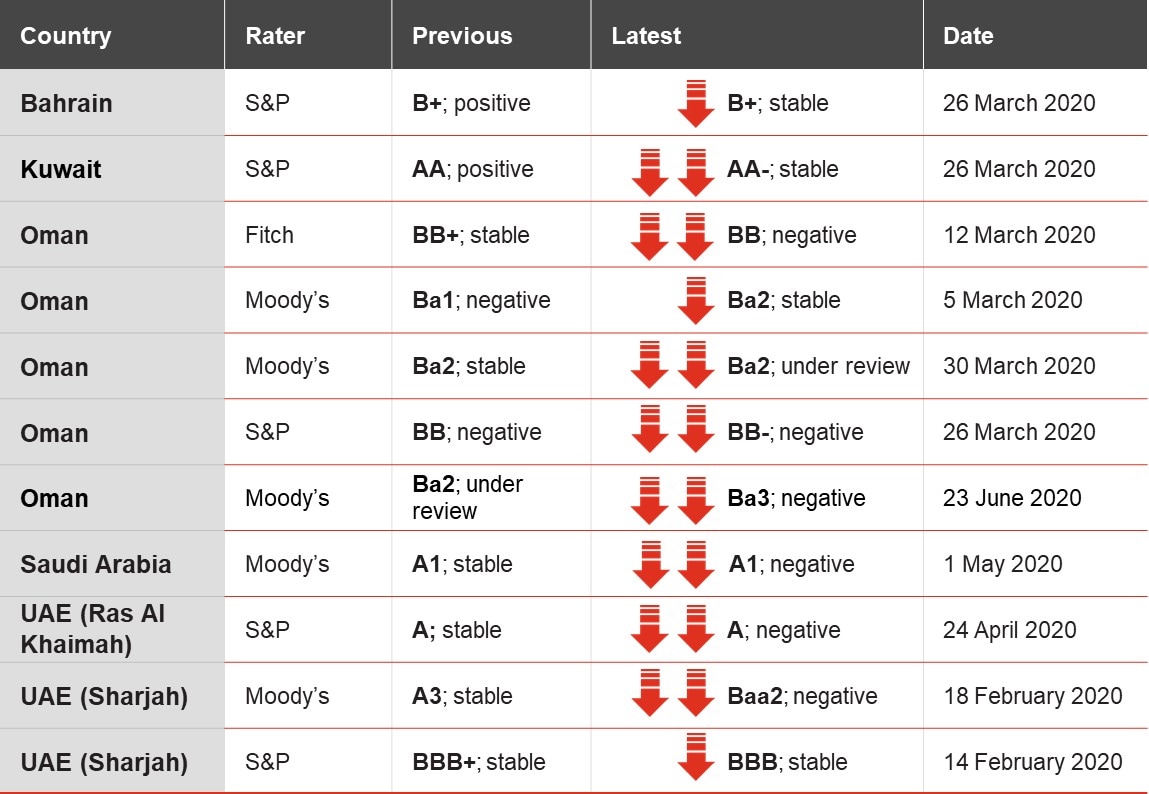2020: A turning point for fiscal policy in the Gulf?
19 July, 2020
COVID-19 has upended government budgets and economic reform plans across the Middle East. Oil-exporting Gulf countries face additional fiscal pressures with falling oil prices and production cuts. Gulf sovereign credit ratings were already under scrutiny, but these twin crises have accelerated credit rating revisions. Several rating actions have already been taken this year, with more expected in the second half of the year. Will 2020 prove to be a critical inflection point in government fiscal policy across the Gulf? In this blog, we explore some of the recent downgrades and their implications for the region.
Credit rating agencies jump into action
A wave of credit rating actions have taken place this year as the credit agencies accelerated their reassessments of Gulf sovereigns.1 Below is a summary of the actions taken up to the end of June 2020.

While the last five years have increased the gap in fiscal resources amongst Gulf countries, this recent round of rating actions has sharpened the dividing lines amongst neighbors. Three camps of fiscal strength have formed and the membership of each is coming into focus:
1. The Fiscally Resilient
Kuwait, Abu Dhabi, and Qatar made it through this recent round of revisions with limited negative actions taken. All three have the fiscal resources to navigate through these tough times. The fiscal stimulus deployed by Abu Dhabi and Qatar highlight their governments’ ability to undertake fiscal expansion to blunt the impact of the downturn. While Kuwait’s fiscal interventions have been modest thus far - due to political constraints more so than fiscal ones - it was the first country in the region into lockdown and will likely be the last out; this bought time for others in the region at a fiscal and economic cost to Kuwait only possible thanks to its deep foreign reserves.
2. The Fiscal Consolidation Frontrunners
The second camp of sovereigns - including Saudi Arabia and emirates like Sharjah and Ras Al Khaimah - have diligently worked to balance economic development objectives with fiscal balance constraints over the last several years; as such, they have weathered the first round of downgrades with minimal impact. While the reasons for the credit revisions for each sovereign are different, overarching trends are clear: the impact of economic contraction, increased expenditures due to stimulus or need to provide economic support to state-owned enterprises (SOEs), and falling revenues all outweigh the ability of fiscal/foreign reserves to support a business-as-usual response. The rating agencies have also warned additional “fiscal slippage” could lead to further downgrades. Saudi Arabia is acting on this as its Minister of Finance announced a redoubling of efforts to increase fiscal discipline.2
3. The Fiscally Constrained
For Bahrain, the limited rating actions taken reaffirm that the country’s recent efforts to stabilize its fiscal situation through the Fiscal Balance Program (along with zero-interest loans from its neighbours3) have been enough to reassure investors of its ability to navigate the downturn. It remains to be seen, however, if investors and the rating agencies will be as forgiving of the back half of this year as its massive fiscal stimulus package is deployed.
Oman’s fall deeper into non-investment grade is worrying in that the negative outlooks signal additional downgrades may occur in the next 6 to 12 months. S&P sums up the challenges Oman as follows:
“[H]ydrocarbon products comprise about 35% of GDP, 60% of current account receipts, and 75% of fiscal receipts…[as such,] the country...has limited fiscal space to adjust gradually.
The government has traditionally taken a very cautious approach to fiscal reforms, aiming to achieve a phased reduction in deficits while maintaining socio economic stability. As a result, Oman has turned from a net government asset position of 60% of GDP in 2015 to a net debt position estimated at 3.9% in 2019.”4
While rating agencies have acknowledged Oman’s creation of a Medium Term Fiscal Plan, limited transparency around the plan and historical hesitancy to enact reforms leaves room for uncertainty.
Implications for Gulf fiscal policy
In the face of COVID-19 and lower oil prices, many emerging markets face declining revenues, increasing expenses, and falling foreign reserves. Gulf countries face an additional risk of also needing to fund current account balance deficits to maintain currency pegs. Over the next two to three years we expect these twin shocks to have implications that are as meaningful for fiscal policy as the 2014-2015 oil crisis:
- Fiscal expansion where possible...: The Fiscally Resilients will likely continue to increase spending to blunt the impact of the downturn. The Frontrunners will likely continue to have modest fiscal stimulus packages that are offset by tactical cuts in recurring opex and capex.
- ...but, increased rationalisation of spend: The Frontrunners and The Fiscally Constrained are all actively undertaking cost rationalisation and cost cutting exercises; The Fiscally Resilient will follow. This episode could also kick start a new round of improvements to public finance management in the region.
- Spectre of deflation: Expect weak inflation numbers (or even deflation in some markets) to decline as government spending in The Frontrunners and The Fiscally Constrained places downward pressure on prices.
- Rising debts for all…: Government borrowing will increase across the region - as evidenced by Abu Dhabi’s5, Qatar’s6, and Saudi Arabia’s7 recent eurobond sales. The Fiscally Resilient will be able to borrow large sums at low yields to buttress their already strong reserves while The Frontrunners will need to complement borrowing with reserve drawdowns. The Fiscally Constrained will find difficulty in borrowing from international markets in the short term, but debt will increase nonetheless as these sovereigns turn to domestic markets, private lending, and bi-lateral/multilateral lines of credit.
- ...but, reserve drawdowns for many: While The Fiscally Resilients will likely try to avoid reserve drawdowns to allow for investments time to recover losses, The Frontrunners and The Fiscally Constrained will need reserves to fund the twin current account and fiscal deficits. New modalities of sovereign wealth fund management will inevitably develop through this and sovereigns will need to consider the need for a formal reserves drawdown rule.
- A renewed focus on monetising government assets: Gulf countries have a wealth of government assets beyond their reserve funds. These include government companies, physical infrastructure, and non-hydrocarbon mineral reserves. Plans to monetise these resources through IPOs, privatisation, and other creative financing options (such as public-private partners) have been on government agendas for years but have progressed at a fairly slow place. However, the increased need for cashflow will likely supercharge asset monetisation efforts.
- A fresh focus on revenue diversification: Just as the previous oil crash brought a push to diversify government revenues, so too will this crisis once countries adjust to a new normal. We could see the few remaining holdouts finally adopt excise tax and VAT. We will also see a new round of VAT increases - as evidenced by Saudi Arabia’s announcement8 - and discussions around introducing additional revenue streams.
- A new focus on fiscal transparency?: Increased borrowing could lead to increased calls by investors for more visibility on how money is spent. Fiscal transparency could increase, but it’s unclear if that’s the only direction of travel possible as this would also mean disclosing potentially large contingent liabilities associated with state owned enterprises and other potential fiscal risks not previously public.
These implications highlight that Gulf governments have to think seriously about public finance management over the next several years as the impact of COVID-19 and lower oil prices reverberate through regional economies. The overall result will likely be leaner budgets and more diversified revenue raising frameworks for government, but also higher debts and potentially lower reserves.
1) For readers not familiar with sovereign credit ratings, visit our primer on sovereign credit ratings.
2) Bloomberg, “Saudi finance minister says country looking at ‘painful’ measures, deep spending cuts,” Gulf News. 03 May 2020.
3) Reuters, “S&P cuts Oman rating deeper into junk, trims Bahrain’s outlook,” Arab News. 29 March 2020.
4) S&P, “Oman Downgraded To 'BB-' On Higher External Risks And Indebtedness; Outlook Negative,” S&P Global. 26 March 2020.
5) Augustine, Babu Das, “Abu Dhabi issues $7b multi-tranche bonds,” Gulf News. 19 April 2020.
6) Ismail, et. al., “Investors Place $45 Billion of Orders for Qatar’s ‘Dream’ Bond,” Bloomberg. 7 April 2020.
7) Saba, Y. & Barbuscia, D., “Saudi Arabia sells $7 billion in three-part bonds as oil squeezes budget,” Reuter. 15 April 2020.
8) Derhally, M., “Saudi Arabia to hike VAT to 15% as kingdom takes measures to buttress economy, finance minister says,” The National. 11 May 2020.







